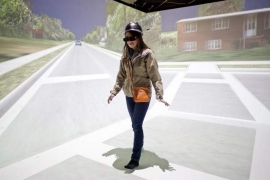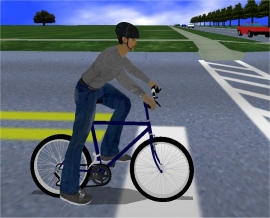Breadcrumb
- Home
- Research Highlights
Research Highlights
Dynamic affordances in embodied interactive systems: The role of display and mode of locomotion
Friday, July 25, 2014 - 12:00am
Abstract

We investigated how the properties of interactive virtual reality systems affect user behavior in full-body embodied interactions. Our experiment compared four interactive virtual reality systems using different display types (CAVE vs. HMD) and modes of locomotion (walking vs. joystick). Participants performed a perceptual-motor coordination task, in which they had to choose among a series of opportunities to pass through a gate that cycled open and closed and then board a moving train. Mode of locomotion, but not type of display, affected how participants chose opportunities for action. Both mode of locomotion and display affected performance when participants acted on their choices. We conclude that technological properties of virtual reality system (both display and mode of locomotion) significantly affected opportunities for action available in the environment (affordances) and discuss implications for design and practical applications of immersive interactive systems.
To read the full paper:
An immersive virtual peer for studying social influences on child cyclists' road-crossing behavior
Friday, July 25, 2014 - 12:00am
Abstract

The goal of our work is to develop a programmatically controlled peer to bicycle with a human subject for the purpose of studying how social interactions influence road-crossing behavior. The peer is controlled through a combination of reactive controllers that determine the gross motion of the virtual bicycle, action-based controllers that animate the virtual bicyclist and generate verbal behaviors, and a keyboard interface that allows an experimenter to initiate the virtual bicyclist’s actions during the course of an experiment. The virtual bicyclist’s repertoire of behaviors includes road following, riding alongside the human rider, stopping at intersections, and crossing intersections through specified gaps in traffic. The virtual cyclist engages the human subject through gaze, gesture, and verbal interactions. We describe the structure of the behavior code and report the results of a study examining how 10-and 12-year-old children interact with a peer cyclist that makes either risky or safe choices in selecting gaps in traffic. Results of our study revealed that children who rode with a risky peer were more likely to cross intermediate-sized gaps than children who rode with a safe peer. In addition, children were significantly less likely to stop at the last six intersections after the experience of riding with the risky than the safe peer during the first six intersections. The results of the study and children’s reactions to the virtual peer indicate that our virtual peer framework is a promising platform for future behavioral studies of peer influences on children’s bicycle riding behavior.
To read the full paper:
Perceiving and acting on complex affordances: How children and adults bicycle across two lanes of opposing traffic
Friday, July 25, 2014 - 12:00am
Abstract

This investigation examined how children and adults negotiate a challenging perceptual-motor problem with significant real-world implications – bicycling across two lanes of opposing traffic. Twelve- and 14-year-olds and adults rode a bicycling simulator through an immersive virtual environment. Participants crossed intersections with continuous cross traffic coming from opposing directions. Opportunities for crossing were divided into aligned (far gap opens with or before near gap) and rolling (far gap opens after near gap) gap pairs. Children and adults preferred rolling to aligned gap pairs, though this preference was stronger for adults than for children. Crossing aligned versus rolling gap pairs produced substantial differences in direction of travel, speed of crossing, and timing of entry into the near and far lanes. For both aligned and rolling gap pairs, children demonstrated less skill than adults in coordinating self and object movement. These findings have implications for understanding perception-action-cognition links and for understanding risk factors underlying car-bicycle collisions.
To read the full paper:
National Science Foundation features research conducted by Hank Virtual Environments Lab
Monday, June 29, 2015 - 7:30am
Abstract
SBE-funded researchers in the Hank Virtual Environments Lab ask a fundamental safety question: What are kids thinking when crossing the street?

Crossing the street is one of the first experiences in a child's life where the concept of taking steps to be safe--looking both ways, listening for danger--comes into play. The researchers in Iowa are looking to learn more about that decision-making process with ultimate goals that include giving parents information that could help them when they're discussing safety with young children. The risks children face on the road are real: 531,340 people were treated in emergency rooms in 2013 after being injured on a bicycle, according to the National Safety Council, an advocacy group aimed at reducing injuries that celebrates June as National Safety Month.
Most of the data the Hank Virtual Environments Lab team has collected focus on children crossing the street on bicycles. Researchers record when kids believe it's safe to cross the street--the point at which they think they see a big enough gap in traffic--and how well that matches up to adults' responses. Children in the 10- to 12-year-old range often are actually close to college students and older adults in terms of the gaps they deem safe to cross, Dr. Jodie Plumert said. The problem is how well they are able to act on those judgements.
"Their timing of movement is not as good as adults," Plumert said. "They delay when they start crossing, and as a result they actually have less time to spare before the next car comes."
Find out more about the research by reading the full article on the NSF website: Beyond looking both ways.